Centrifugal juicers are not a new product on the market, they were even produced in the USSR. Nevertheless, due to the simplicity of design and, accordingly, cheapness, they are still popular, especially among those who do not need to squeeze juice from something exotic like rhubarb or dill. Also, centrifugal juicers are traditionally considered more suitable for harvesting juice “on an industrial scale”, due to the higher speed of operation.

However, the hero of this story – Vitek VT-1600 – is clearly not about “industrial scale”. It’s a cute little juicer that’s easy enough to fit into even the small kitchen of a studio apartment, with a completely neutral design…well, we’ll see.
Characteristics
| Manufacturer | Vitek |
|---|---|
| Model | VT-1600 |
| Type | centrifugal electric juicer |
| Country of Origin | China |
| Warranty | 1 year |
| Service life * | 3 years |
| Rated power | 300 W |
| Max power | 1000 W |
| Number of speeds | 2 |
| Feed opening diameter | 75 mm |
| Juice container volume | 600 ml |
| Retail offers |
* Contrary to common misconception, this is not the period after which the device will definitely break. However, after this period, the manufacturer ceases to bear any responsibility for its performance and has the right to refuse to repair it, even for a fee.
Equipment
The device is delivered in a cardboard box with two foam inserts inside, between which there are a fully assembled juicer packed in plastic bags, a juice jug, instructions and a warranty card.

At first sight
For a person who has a minimal idea of the principles of operation of a centrifugal juicer, there is nothing incomprehensible in the design.
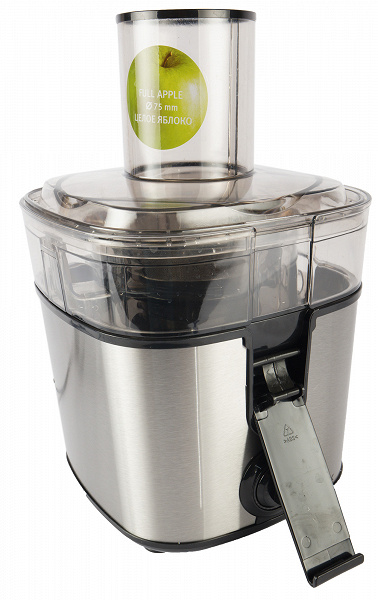
A container for collecting cake is installed on top of the motor block, and a cover with a “pipe” for supplying raw materials is placed on top of it. Both elements are made of transparent plastic.
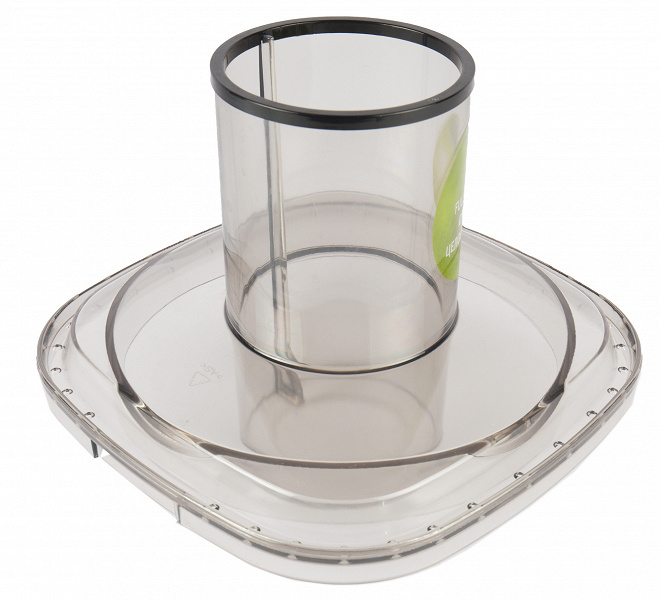
A rather massive black plastic pusher is provided for pushing through the raw materials. Due to the fact that there is a guide in the shaft, and a cutout along the entire length on the pusher, it can only be inserted in the only, correct way.
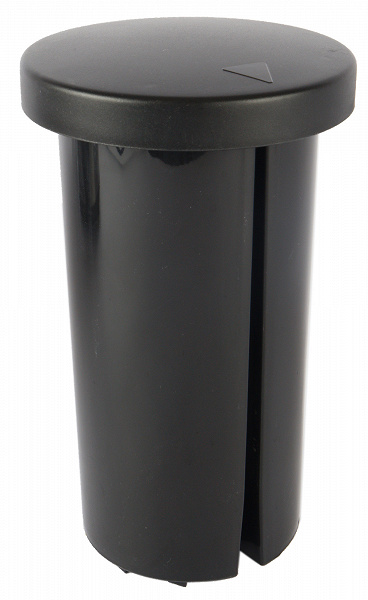
After installing the pulp container (and before installing the lid), put a squeezing mesh with a grater on the shaft.

The assembled structure is fixed on the sides with two black plastic clips.

The connection of the motor shaft with the squeezing mesh is plastic / plastic.
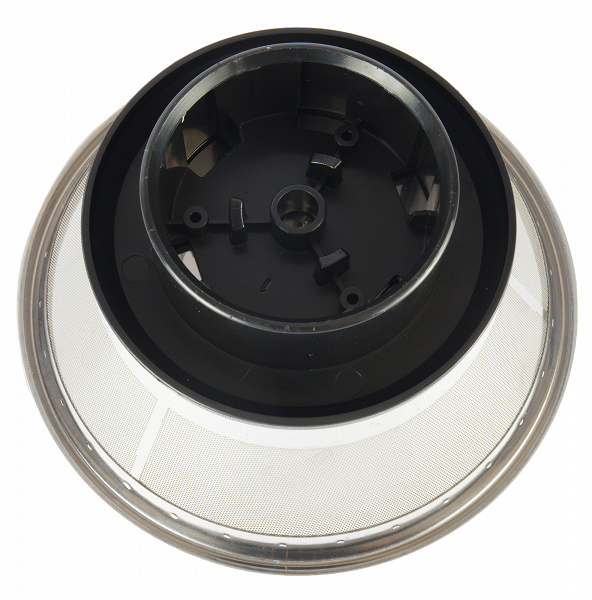
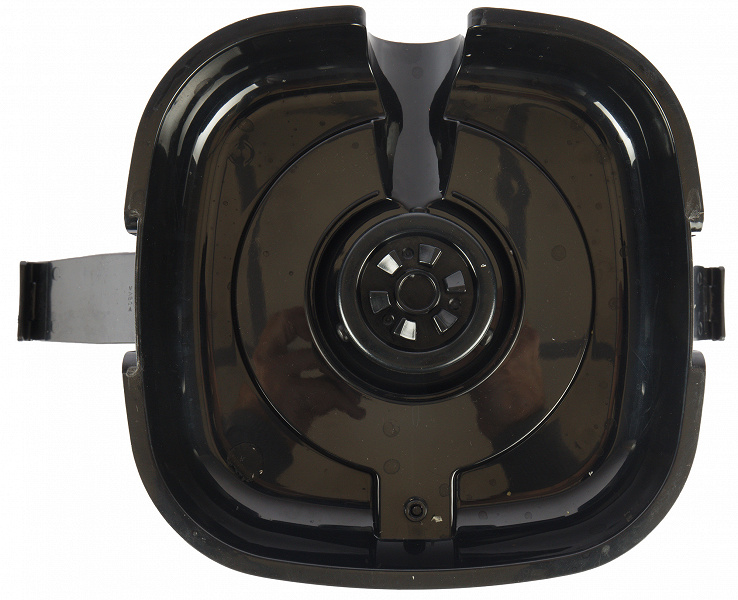
The bottom of the device is completely standard: four suction cups, ventilation holes for engine cooling, a sticker with the main technical characteristics of the model.
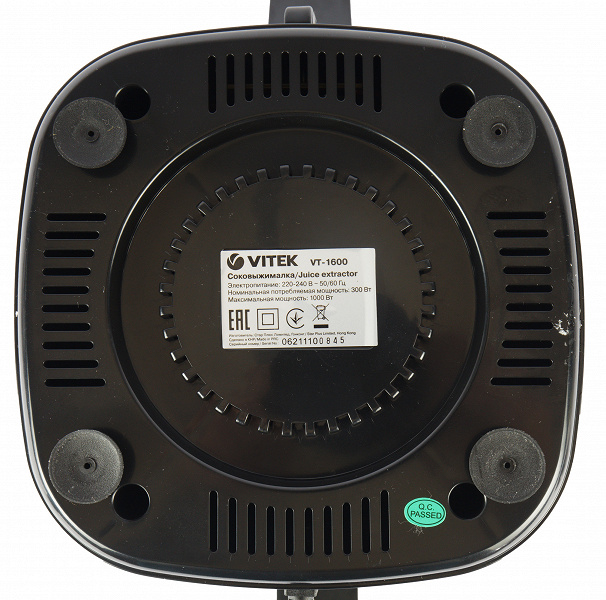
The spout from which the juice flows is not equipped with any locking mechanism, so if you remove the juice jug and do not immediately substitute any replacement, drops of juice will drip onto the table.
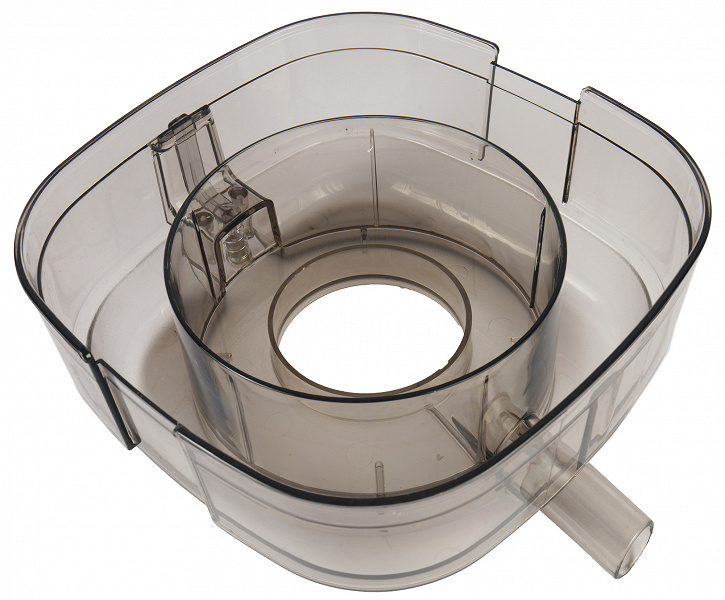
The jug is made of the same slightly darkened transparent plastic as the pulp container and lid, and is equipped with a hinged lid and a skimmer.
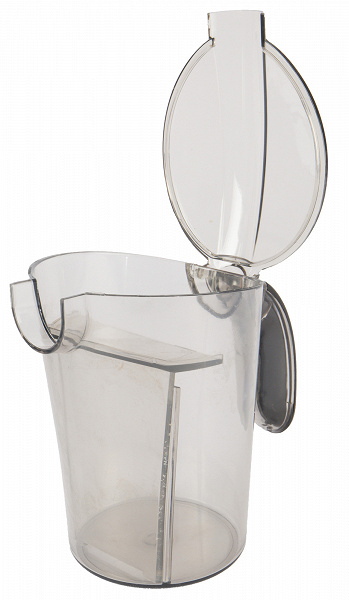
In general, as we said at the very beginning, the design of the juicer is as simple and clear as possible. The accuracy of the execution of the details did not cause us any complaints, the stages of assembly and disassembly are obvious in their sequence and do not constitute any difficulty. At least at the time of inspection;)
Instruction
A5 size user manual printed on coated paper, black and white printing. The book is already rather thin, and given that it is in six languages, it becomes clear why only five pages fell to the share of Russian. However, by and large, anyone who has ever dealt with centrifugal juicers does not really need it. Unless to refresh in memory what raw materials to squeeze at what speed.
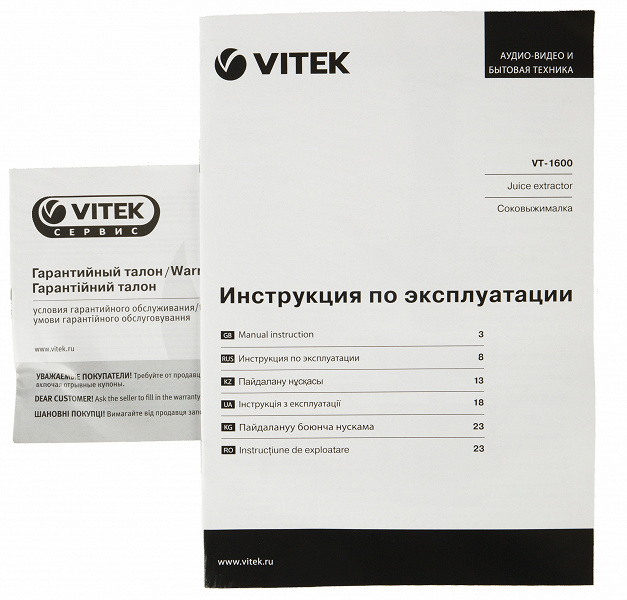
Control
Since our juicer has two speeds, the only control is, as expected, a three-position switch.
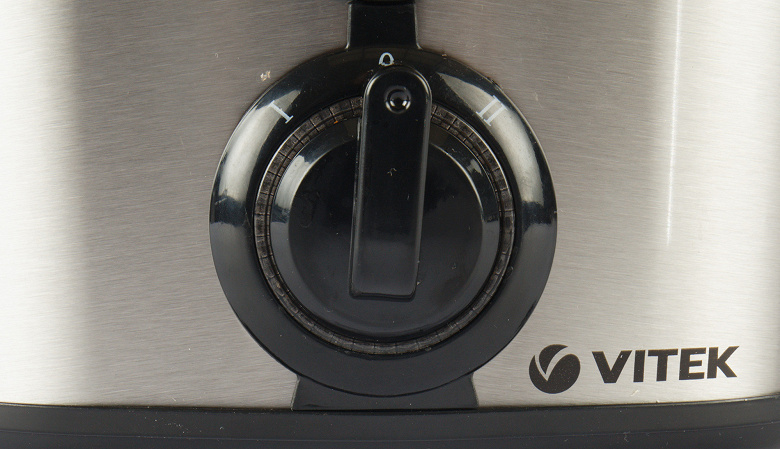
Exploitation
The instruction recommends washing the parts in contact with the products with water before use, and then dry them. We did just that. Further operation of the juicer showed that the design, which at first glance looks simply original and fresh, has its own characteristics, which are not always obvious.
The diameter of the shaft hole is indeed 75 mm, but there is one “subtle nuance” – due to the presence of a guide for the pusher inside it, an ideal ball with a diameter of 75 mm will not pass through it – about 2.5 mm of useful diameter “eats” the ledge of the guide.
The experience with squeezing juice from whole apples (we specially selected those that crawled into the hole and only removed the stalks from them) left an ambivalent impression. Firstly, approximately in the middle, when the diameter of the contact of the apple with the grater is maximum, the engine definitely does not like this load: the rotation slows down, the juicer begins to noticeably “shake”, and once we even managed to achieve the engine overheating protection (at the same time we made sure that it works). Secondly, once an unfinished piece of apple, after removing the pusher from the shaft, “shot” outward, almost hitting the tester in the eye. And thirdly, grinding apples “together with the booths” (that is, without removing the core and seeds) makes the color of the juice much less aesthetic: it acquires a brownish, earthy hue. In general, a large neck diameter is, of course, useful, but it is irrational to shove anything in there, guided by the only suitable diameter;)

An unexpected consequence of the compact design is that emptying the pulp container turns out to be a somewhat more complicated operation than we are used to: if for many other centrifugal juicers it is enough to simply “unfasten” it from the device and shake it out, then here you have to do a complete disassembly: release the two clamps , remove the lid, then remove the squeezing mesh, and only then remove the container and empty it. At the same time, its volume is not so large – a little less than a liter, so when processing a large amount of products, the above operation will have to be carried out quite often.
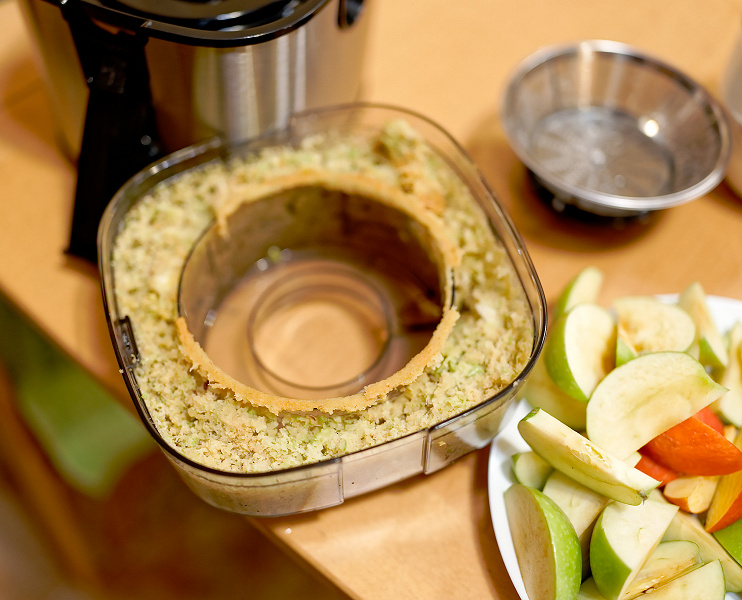
This nuance, in fact, eliminates one of the traditional advantages of centrifugal juicers: the speed of processing products. That is, the speed of the processing (squeezing) itself is high, but the need to often take quite long pauses to disassemble the juicer and remove the cake nullifies it.
We discovered another funny moment when we resumed testing the device a few days later. Apparently, the bottom of the cake container was not washed very carefully, or a few drops of juice were missed that fell on the top of the motor block with the container removed. In general, the container “glued” the bottom to the engine block. It was… unexpected. And we had to loosen it slowly to take it out without breaking it for about 15 minutes.
But what we frankly liked was the defoamer in the complete jug. It really cuts off almost 95% of the foam – it just stays in the jug. And all the business is not to implement it formally, but to strain your brains a little.
Care
Immediately after use, the juicer should be completely disassembled and all parts, except for the motor unit, washed with warm water and a non-aggressive detergent (or even without it – most juices and cakes are perfectly washed off with just water). The mesh should be cleaned with a brush (our old toothbrush did an excellent job with this task), in no case letting it dry. The motor unit may be cleaned with a moderately damp cloth.
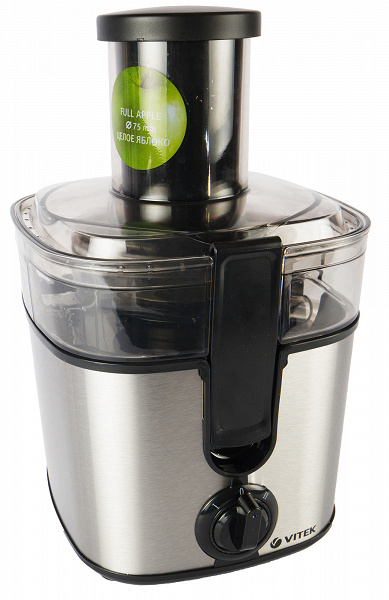
Assemble the juicer only after all parts are dry. None of the parts are dishwasher safe.
Our measurements
The maximum power consumption was recorded when processing whole apples and amounted to 361 watts.
practice tests
Since the product in front of us is obviously quite ordinary, we did not reinvent the wheel and tested the Vitek VT-1600 according to our standard method, plus squeezed oranges additionally, because we like orange juice 🙂
Required Test #1: Granny Smith Apples
Since we already had the result with whole apples, for the second test we tried to cut them all the same. Testing conditions are standard: how much juice will be obtained from 1 kg of feedstock and for how long.

The second result turned out to be significantly better than the first, so we present it here.

Result: 1 minute 36 seconds, 571 grams of juice (no foam).
Required Test #2: Carrots
Peeled and cut 1 kg of fresh carrots.
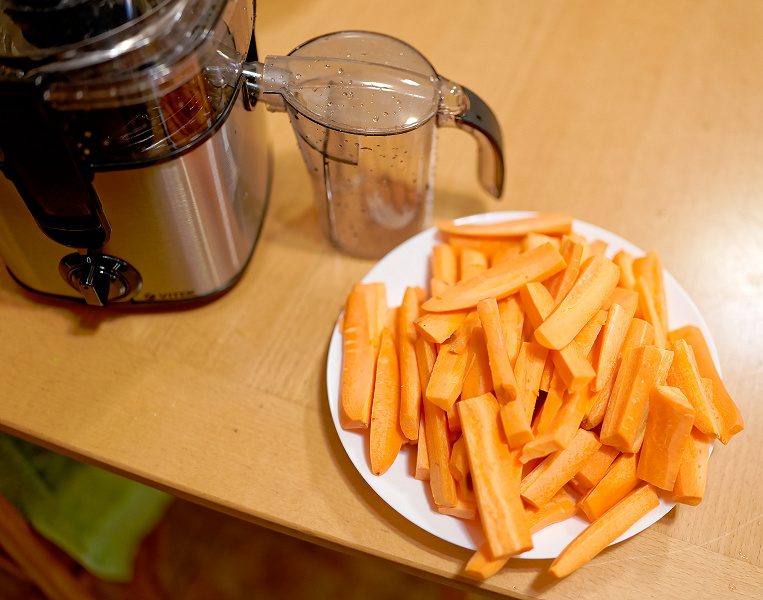
The juicer worked without any problems.
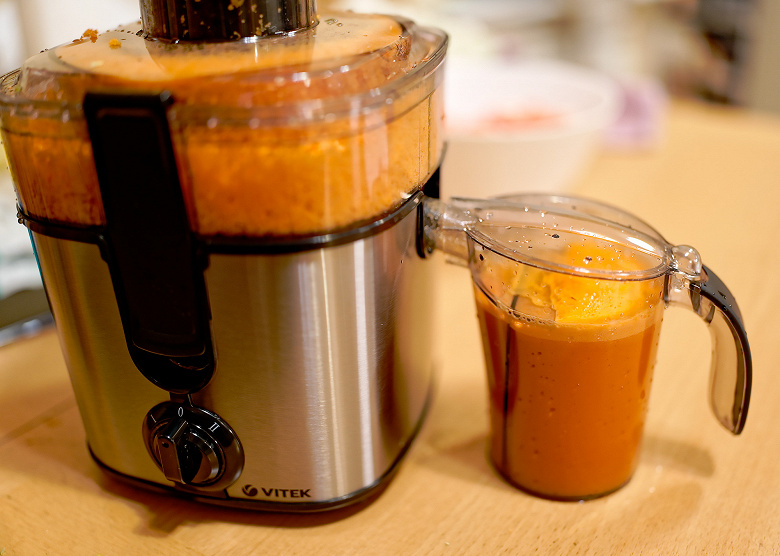
Result: 1 minute 38 seconds, 528 grams of juice (no foam).
Mandatory test number 3: white cabbage
We did not expect miracles from cabbage at all, centrifugal juicers do not like this product very much. But a technique is a technique.

It turned out surprisingly quickly and even very effectively.
Result: 1 minute 2 seconds, 584 grams of juice (no foam).
Required Test #4: Pink Grapefruit
Soft fruits (including grapefruit) the instruction prescribes to squeeze at the first speed. We decided not to argue with her.
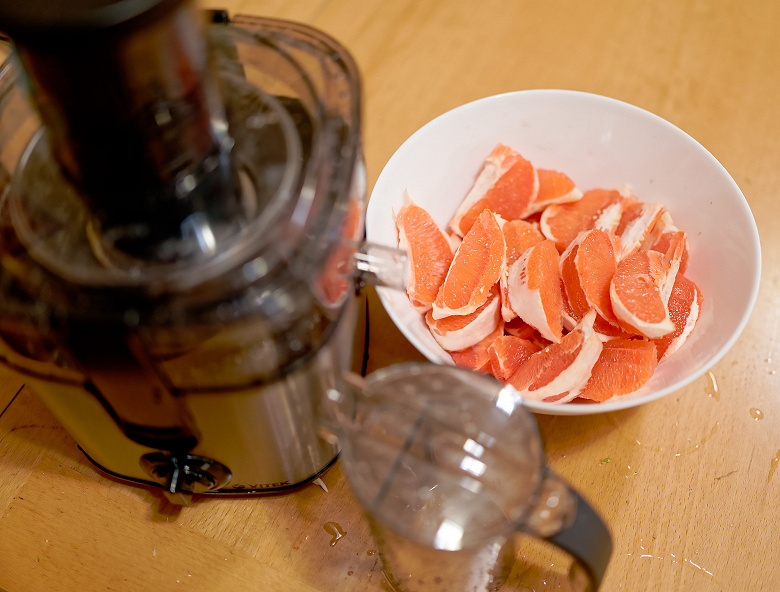
Everything was squeezed out quickly, although we saw more juice coming out. The foam, when drained from the complete jug, as always, was perfectly cut off, but there was a lot of pulp in the juice itself.

Result: 50 seconds, 526 grams of juice (no foam).
oranges
With oranges, it turned out to be about the same story as with grapefruits – which, however, is not surprising. And also quite a lot of pulp in the juice.
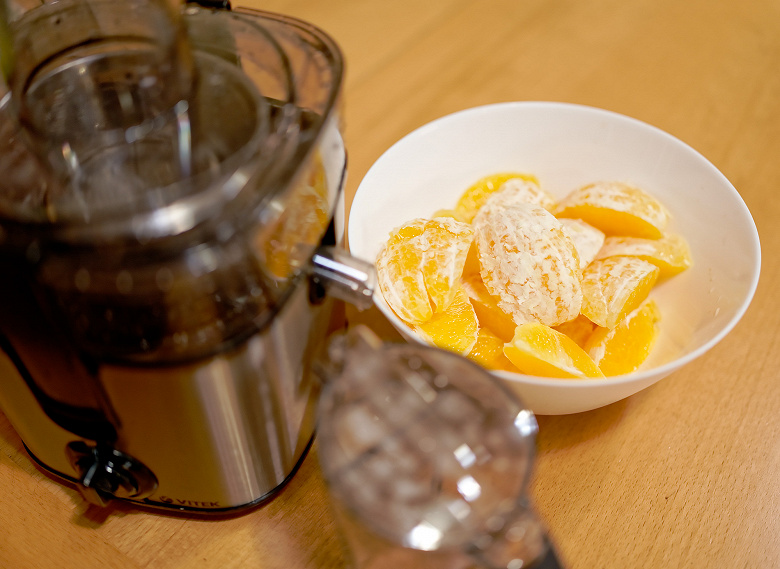

Result: good.
Summing up the results of mandatory tests according to the iXBT.com methodology
Based on the results of mandatory tests, you can calculate the average speed and efficiency for the Vitek VT-1600 centrifugal juicer using the iXBT.com method. The speed indicator was 1 minute 16 seconds , efficiency – 552 grams .
You can see for yourself the results of all the juicers we tested , the result of comparing Vitek VT-1600 with competitors in its group (centrifugal juicers) is as follows: in terms of speed it is below the average, in terms of efficiency it is almost in the middle.
findings
The Vitek VT-1600 centrifugal juicer is an inexpensive, neat looking appliance with a neutral design and rather small size. He copes with his tasks with dignity, demonstrating quite average results.
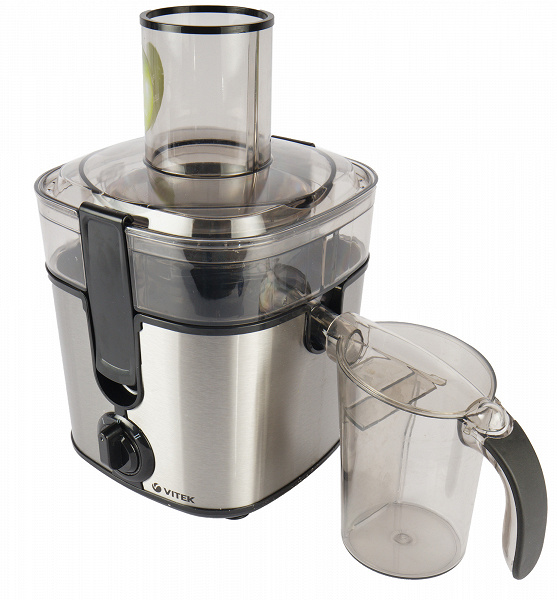
The operation features revealed during the testing process allow us to conclude that this juicer is most suitable for those who consume freshly squeezed juices not very often and, let’s say, “without fanaticism”: glasses, not liters, and by no means every day.
Pros :
- compactness and simplicity
- nice price
- very good defoamer in the complete jug
- wide neck
Cons :
- the need for complete disassembly to empty the container with cake
- small power




